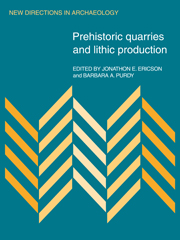Book contents
- Frontmatter
- Contents
- List of contributors
- Dedication
- Part 1 Introduction
- Part 2 Procurement, production, and exchange
- 2 Mount Jasper: a direct-access lithic source area in the White Mountains of New Hampshire
- 3 Procurement without quarry production: examples from southwestern Idaho
- 4 The 63-kilometer fit
- 5 Monopoly or direct access? Industrial organization at the Melos obsidian quarries
- 6 Lithic material demand and quarry production
- 7 Economic aspects of prehistoric quarry use: a case study in the American southwest
- 8 Preliminary report on the obsidian mines at Pico de Orizaba, Veracruz
- 9 State-controlled procurement and the obsidian workshops of Teotihuacán, Mexico
- Part 3 Technology and techniques
- Index
3 - Procurement without quarry production: examples from southwestern Idaho
Published online by Cambridge University Press: 04 August 2010
- Frontmatter
- Contents
- List of contributors
- Dedication
- Part 1 Introduction
- Part 2 Procurement, production, and exchange
- 2 Mount Jasper: a direct-access lithic source area in the White Mountains of New Hampshire
- 3 Procurement without quarry production: examples from southwestern Idaho
- 4 The 63-kilometer fit
- 5 Monopoly or direct access? Industrial organization at the Melos obsidian quarries
- 6 Lithic material demand and quarry production
- 7 Economic aspects of prehistoric quarry use: a case study in the American southwest
- 8 Preliminary report on the obsidian mines at Pico de Orizaba, Veracruz
- 9 State-controlled procurement and the obsidian workshops of Teotihuacán, Mexico
- Part 3 Technology and techniques
- Index
Summary
Obsidian was the lithic material preferred by the aboriginal inhabitants of southwestern Idaho but archaeologists and ethnographers have reported that this material was obtained in Yellowstone National Park and central Oregon. Evidence for tool production in the vicinities of the two local sources is minimal, superficially indicating little procurement of these materials. However, X-ray fluorescence analysis of regional sources and archaeological collections demonstrates that, in fact, both sources were exploited over a period of 10,000 years. This study indicates that lithic-tool production occurred primarily at the consumer sites rather than at the source areas.
Introduction
Obsidian commonly occurs in parts of northwestern North America and this material was widely used by regional aboriginal groups. Archaeologists have been investigating the significance of outstanding quarries such as Obsidian Cliff since 1879 (Holmes 1919, 214). Obsidian artifacts are abundant in archaeological sites in southwestern Idaho but the raw material for these items has long been assumed to have been imported from the well-known sources in Yellowstone National Park and/or central Oregon (Gruhn 1961, 50). The local obsidian resources were either ignored or dismissed as occurring ‘only in small pieces unacceptable for tool making’ (Davis 1972, 42). Ethnographic reports reinforced the case against procurement at the southwestern Idaho sources. The Shoshoni in west central Idaho ‘must’ have obtained their obsidian ‘from no other place’ than Glass Buttes in central Oregon (Liljeblad 1957, 88).
- Type
- Chapter
- Information
- Prehistoric Quarries and Lithic Production , pp. 23 - 34Publisher: Cambridge University PressPrint publication year: 1984
- 9
- Cited by



